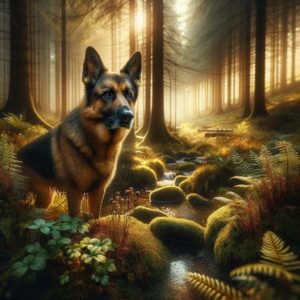For many, a wagging tail is synonymous with a happy dog. However, tail wags can convey a variety of emotions and messages, from excitement to fear. By learning to interpret the secret language of canine tail movements, we can better understand our dogs’ emotions and strengthen the bond between human and pet. Let’s dive into the world of tail-wagging tales and discover what your dog’s tail is trying to tell you.
The Excited Wag: The Full-Body Experience
When a dog’s tail wags energetically and their entire body seems to wiggle, this usually signifies happiness and excitement (Horowitz, 2009). This type of wag is commonly seen when dogs greet their owners after a long day or meet a new playmate at the park.
The Confident Wag: High and Proud
A tail held high and wagging slowly often indicates confidence and dominance. This posture allows dogs to release more scent from their anal glands, signaling their presence to other dogs. If your dog displays this wag, they are likely feeling secure and in control of their environment.
The Submissive Wag: Low and Slow
A tail held low and wagging slowly suggests a submissive or insecure demeanor. This type of wag can be seen when a dog meets a new, larger dog or encounters an unfamiliar situation. By keeping their tail low, the dog is minimizing the release of scent and attempting to appear less threatening.
The Fearful Wag: Tucked and Still
A tail tucked tightly between a dog’s legs is a sign of fear or anxiety. This posture is often accompanied by other signs of stress, such as panting, drooling, or trembling (Schilder et al., 2014). If your dog’s tail is tucked, it’s essential to identify and address the cause of their anxiety to help them feel safe and secure.
The Ambivalent Wag: The Asymmetrical Dance
Research has shown that the direction of a dog’s tail wag can also convey information. A wag that leans more to the right indicates positive emotions, such as happiness or excitement, while a wag leaning more to the left may signify negative emotions, like fear or aggression (Quaranta et al., 2007). This subtle difference in tail movement can provide valuable insights into your dog’s emotional state.
Decoding the Canine Tail-Wagging Language

By learning to interpret the secret language of canine tail movements, we can better understand our dogs and respond to their emotional needs. This increased understanding fosters a stronger bond between pet and owner, ensuring a happier, more harmonious life together.
References:
Horowitz, A. (2009). Inside of a dog: What dogs see, smell, and know. Scribner.
Quaranta, A., Siniscalchi, M., & Vallortigara, G. (2007). Asymmetric tail-wagging responses by dogs to different emotive stimuli. Current Biology, 17(6), R199-R201. doi:10.1016/j.cub.2007.02.008
Schilder, M. B., van der Borg, J. A., & Vinke, C. M. (2014). Dominance in domestic dogs: A quantitative analysis of its behavioural measures. PLoS ONE, 9(8), e102330. doi:10.1371/journal.pone.0102330








